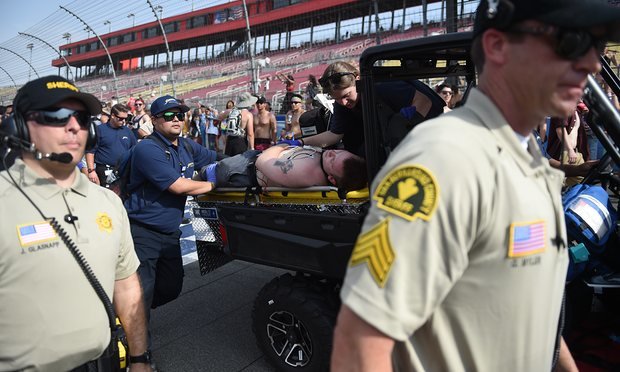
Concert promoters have relocated festivals to poorer, inland cities in the wake of restrictions in LA over drug-related deaths.
They have found an official welcome in cash-strapped San Bernardino County despite lawsuits and recrimination in LA, where concertgoers used to flood hospital emergency wards.
But the death of three young people and the arrest of hundreds of others on drug offenses at a concert last month in Fontana, a city in San Bernardino, has triggered a fresh outcry which could eventually force festival organizers to move again.
"The county should not be sponsoring events that clearly create an environment of illegal drug use that results in deaths," Janice Rutherford, who sits on the county board of supervisors, told the Observer. "I think we should learn from the experiences in LA. It didn't work there. There are no conditions that would make it work any better here."
Karan Slobom, a San Bernardino resident and activist, said she hoped Live Nation Entertainment, a corporate giant which runs rave franchises, would pack up and leave, no matter the estimated $1.4m revenue loss to county coffers and other losses to local businesses.
"It's a multibillion dollar corporation and brings in the money. But there's a dark side to these raves. Those [fatalities] are somebody's kids. Somebody loved them. They had a life ahead of them."
The recent backlash could disrupt the ambitious growth plans of festivals which have drawn top electronic dance, hip-hop and rap stars, plus legions of fans. Hard Events, a leading promoter, has dabbled in the UK, Australia and Japan and hopes to continue expanding.

The latest tragedies will reverberate, said EDM Life, an electronic dance community news website. "Is this the end of raves in SoCal?"
It is not the end. More raves are planned this summer and autumn. But there is widespread concern at the human cost and business model. Such angst is a far cry from the Beach Boys' stereotype of California as a carefree music wonderland by the Pacific Ocean.
Raves are increasingly held far from the coast in a region known as the Inland Empire, a sprawl of towns, cities and high desert east of LA. This is the California that tourists seldom see - suburbs and exurbs known not for celebrity glamour, but for gang shootings and fiscal fiascos.
The arrival of rave festivals in recent years sprinkled some stardust and dollars on the region. One reason for the migration, after all, was the concerts' burgeoning popularity and need for bigger venues.
With attendance doubling each year, Hard Events started moving east in 2014, first to venues outside the city of LA, then outside the county of LA.
Insomniac Events, another promoter, has held Nocturnal Wonderland raves at the the San Manuel Amphitheater in Devore, another San Bernardino community, since 2015. Live Nation Entertainment, which earned $7.2bn last year, owns Hard and Insomniac.
The other reason to migrate, however, was that authorities and venue owners in LA recoiled in the wake of deaths, lawsuits from bereaved families and lobbying by police and first responders.
Marc Futernick, director of emergency services at LA's California hospital medical center, used to see dozens of ravers wheeled in, suffering organ failure from ecstasy-induced overheating or with brain damage from excessive water intake, which lowered sodium levels.
"We never see this pathology at any other events. There's something about the culture of these events that invites rampant drug use. We see the same pattern - tens of thousands of heavily intoxicated people. I don't see why we allow events to continue where we know we will get dozens of ill patients, several of which will die."
The Fontana deaths, said Futernick, should be a wake-up call. "Every city should see what's going on. They're just moving out to other venues. But the pattern is the next city says: 'Well, we'll bring in a few extra doctors and make a few million dollars'. It's insanity."
Aware of the scrutiny, Live Nation provided ample medical resources at the Fontana concert, including six first aid stations, three ER doctors, 20 nurses, 88 emergency medical technicians and a medevac helicopter.
The company declined an interview request for this article but forwarded a brief statement. "We were deeply saddened to learn about the deaths of three people who attended the festival this weekend. While the causes of the deaths have not yet been determined, we ask everyone to keep them in their prayers. Our sincerest thoughts and condolences are with their family and friends."
Missi Woolridge, founder of Healthy Nightlife, a consulting firm, said drug emergencies were a feature of many mass gatherings and that with proper policies and resources, raves could promote harm reduction.
"This is an opportunity to create a safe environment for young people to socialize, experience life, and protect them while they may experiment with substances. Until we get real about drug use at events, we, unfortunately, are going to keep seeing fatalities. If we can't keep drugs out of prisons, we absolutely can't keep them out of festivals and other nightlife settings."
Intensive policing, Woolridge added, could backfire by encouraging rave patrons to "pre-load" before entering. "Then, during the event, the event producers and medical teams are required to deal with the burden."



Reader Comments
to our Newsletter